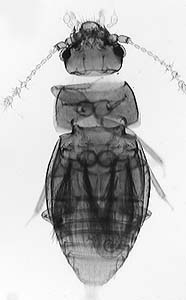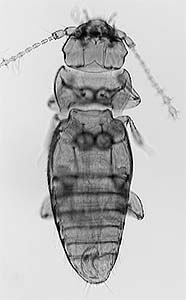Certain genera of Ptiliidae posses species that exhibit forms of polymorphism (Dybas, 1978; Taylor 1981, 1980). The polymorphic states are generally divided into two categories: a 'normal morph' which possesses all the 'normal' characters composing featherwing beetle adult morphology, and 'vestigial morphs' that exhibit reduced or absent eyes and wings, shortened elytra, and absence of body coloration. At times the appearance of the two morphs varies so much that they may be mistaken for separate species. 'Normal' and 'vestigial' morphs are present in both sexes, and both forms occur at the same time within a population.
Polymorphism is known within species of Ptinella, Pteryx and Ptinellodes. Taylor (1981) observed that polymorphism occurs in Ptinella aptera and P. errabunda seasonally in wild populations and was influenced by temperature in laboratory cultures, leading Taylor to conclude that "morph determination is based on a physiological switch sensitive to temperature and possibly other adaptively relevant environmental factors." Though both morphs produce offspring, Taylor notes "Ptinella alatae are reproductively superior to apterae."
Above left: Pteryx sp., normal morph, exhibiting normal
eyes, wings and coloration.
Above right: Ptinella sp., vestigial morph, exhibiting reduced eyes,
wings and color.







 Go to quick links
Go to quick search
Go to navigation for this section of the ToL site
Go to detailed links for the ToL site
Go to quick links
Go to quick search
Go to navigation for this section of the ToL site
Go to detailed links for the ToL site